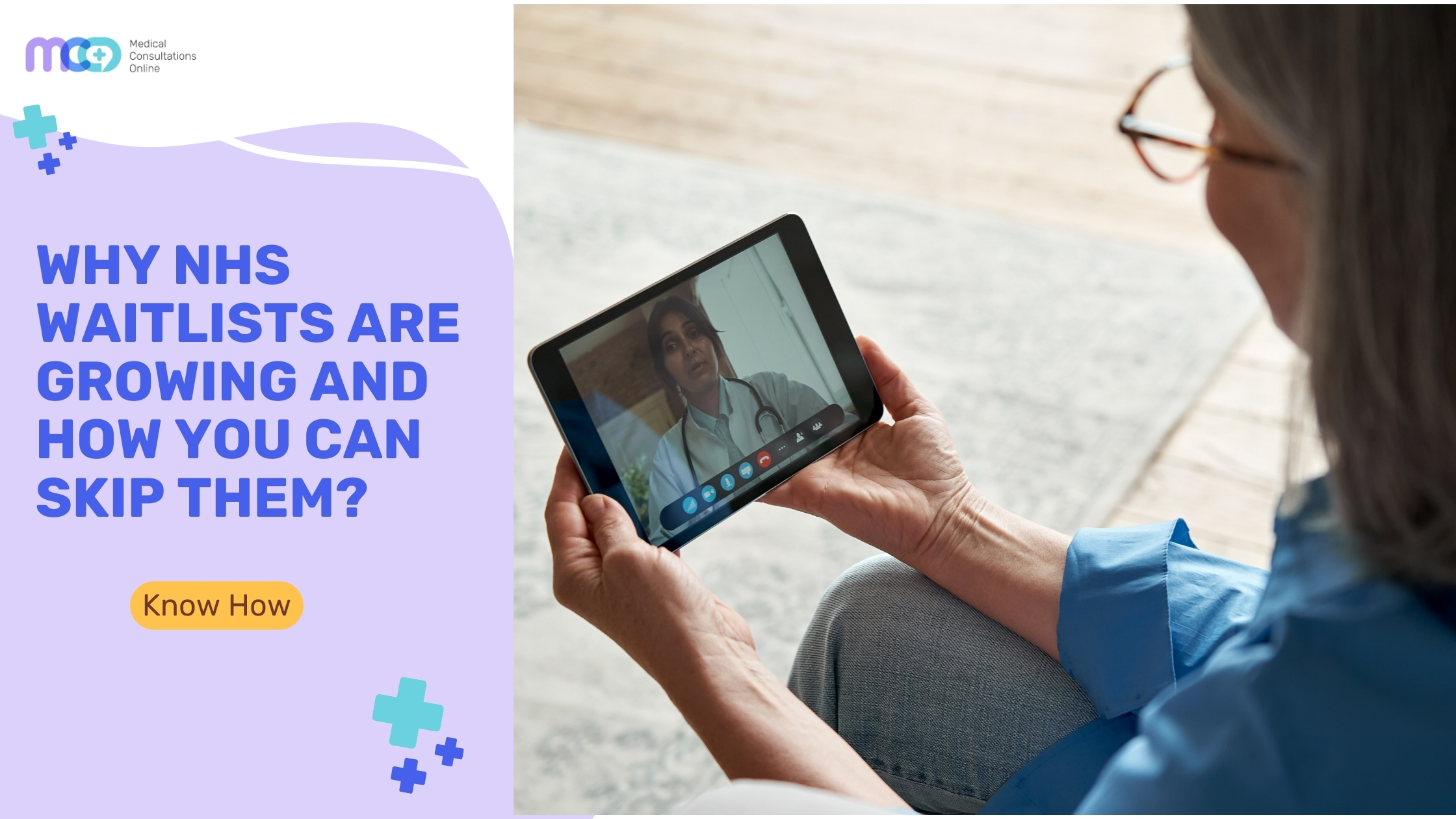How to Skip NHS Waitlists with Fast Online Consultations

Hello There! In today’s fast paced world, healthcare shouldn’t mean weeks of phone queues or months on a list. This friendly guide explains why NHS waitlists are growing and what those waiting list numbers really mean. Learn how to move sooner using simple, safe online options for care and advice. If it isn’t an emergency, you can get sensible advice, a prescription, or a referral without waiting. Emergency reminder: severe breathlessness, chest pain, confusion, or blue lips call 999. For urgent but not life-threatening issues, use NHS 111.
A quick story to set the scene
It’s Monday, 7:59am. Dan has his phone in one hand and a cup of tea in the other. He needs help for a stubborn cough that’s kept him up all weekend. As the clock strikes eight, he dials his GP surgery… engaged tone. He tries the website… fully booked. By lunchtime he’s no closer to being seen, his workday’s gone sideways, and he’s still coughing.
Now meet Amira. She has a flare up of eczema and a big presentation tomorrow. She books an online consultation that afternoon, shares photos, speaks to a UK–registered clinician, and collects treatment locally. If she later needs a hospital dermatologist, she remains on the waiting list but avoids a week of discomfort.
These two moments capture today’s reality: lots of need, limited slots, and the value of getting sensible care started early.
What an NHS “waiting list” actually means?

Think of the NHS waiting list as a queue outside a very busy clinic. Your “ticket” is called a referral-to-treatment (RTT) pathway. You can have multiple tickets if waiting for different issues, such as a knee problem or a skin check. Millions of people are currently in that queue. Many are seen within a few weeks, but others wait much longer. Being on a waiting list for elective or hospital treatment means waiting for non-urgent, consultant-led care. The NHS aims to start care within 18 weeks, but heavy pressure often delays treatment.
Why NHS waitlists are growing ?
There’s more demand than there are slots. GP teams deliver many same-day appointments while still referring numerous patients to hospitals. That keeps the specialist queues long. Staffing is stretched. Even with a growing workforce, some services still don’t have enough staff in the right place at the right time. Clinics and operating lists can’t always run at full tilt. Recovery takes time. The NHS has a step-by-step plan to get closer to the 18-week standard again. Progress is happening, but it’s a multi year climb, not an overnight fix.
Put simply, the pipeline is busy, so even checking the NHS App or calling at 8am may still mean waiting.

What long waits do to real life?
A long spell on the waiting list isn’t just a number on a chart. Pain can creep up. Sleep gets patchy. Workdays go sideways. Parents juggle childcare and can’t plan. People feel stuck. People say, “I tried the practice website, called the surgery, checked the NHS App, but was told to try tomorrow.” That loop is exhausting. For straightforward issues like urine infections, eczema, migraine plans, contraception, or repeat prescriptions, online care can start treatment while on the waiting list.
How online medical consultations help you move sooner (safely)?
Online care isn’t about dodging the NHS. It’s about removing bottlenecks at the start so you’re not stuck waiting to begin simple, appropriate treatment.
What it usually looks like:
- You complete a short, secure form in your own time.
- A UK-registered clinician reviews your answers (and photos if relevant), then speaks with you by video or phone if needed.
- If it’s appropriate, you get an e-prescription and collect your medicine from a nearby pharmacy the same day.
- You receive clear “red flag” advice and what to do if things worsen.
- If in-person tests or specialist care are needed, you’ll be guided on the next steps including referral options.
This approach won’t remove you from a waiting list for elective treatment, but it keeps you active while symptoms continue.

NHS routes vs private online care, picking what works today
Staying within the NHS? The NHS App is your best friend for booking requests, messages, results and prescription tracking. It cuts missed calls and helps keep your place in the system tidy while you wait for treatment. Need certainty today? A reputable private online service can assess you the same day, prescribe when appropriate, and issue letters or referrals. It won’t remove you from the waiting list, but helps calm symptoms, record your history, and optimise your clinic slot.
Many use the NHS App to stay in the queue while starting treatment with an online consultation.
A short, true-to-life journey
Ben, 39, gets sinus pain every winter. This time it’s worse, and the soonest non-urgent slot at his surgery is next week. He completes an online consultation on his lunch break. A clinician reviews his history, checks details on a quick call, and advises self care with a backup prescription. Ben sleeps better that night, keeps working, and still attends his NHS appointment later to talk about prevention.
Maya, 28, notices a painful skin infection before a weekend trip. She submits photos via a secure form, receives a same-day antibiotic prescription, and collects it from a nearby pharmacy. If she has repeat infections, she’ll be referred for tests, but hasn’t spent the weekend waiting in pain.
How Medical Consultations Online (MCO) works (simple, safe, same-day)?
You start with a secure online assessment. A UK-registered clinician reviews your case and contacts you at your chosen time. If treatment is appropriate, a same-day prescription is issued for collection at any UK pharmacy. You can book a follow up appointment if symptoms persist, and your clinician will contact you at the scheduled time. If symptoms need tests or a face-to-face exam, MCO gives guidance and referrals while you stay on the waiting list. MCO is private, not your GP, continue using NHS App and practice digital forms.

Smart, simple tips to avoid getting stuck
Write down your main symptoms, when they started, and anything that makes them better or worse. Add photos for skin and eye issues. Submit your practice’s online form early in the day, then check your NHS App messages so you don’t miss replies. If slots are limited and your issue suits remote care, start today with an online consultation while awaiting complex treatment.
Quick questions, straight answers
Why are NHS waitlists growing right now?
More people need help, staffing is tight in some areas, and the NHS recovery plan is staged. The result is longer queues in some specialties while capacity continues to build.
Can online care help if I’m already on a waiting list for hospital treatment?
Yes for suitable problems it can begin treatment, and line up referrals while you wait. It won’t cancel a waiting list for elective treatment if you need a procedure, but it avoids weeks of waiting.
Is there a difference between NHS online tools and private online services?
NHS online tools are part of your surgery and hospital pathways. Private online services are separate and can often see you the same day for appropriate issues. Many people use both.
Is online care safe?
For common conditions, online care is safe and effective when provided by regulated clinicians with clear red-flag advice and follow-up. If something needs hands-on examination or urgent care, you’ll be directed accordingly.

Conclusion
NHS waitlists are growing, but you still have options. If suitable for online care, start today to ease symptoms and plan treatment while staying on the waiting list. Continue using the NHS App for bookings, messages, prescriptions, and combine with online consultations when appropriate. If you suspect your symptoms are worsening or you’re worried, please contact your healthcare provider. Stay healthy!
This article explains why NHS waitlists continue to grow and how safe online consultations can help you move forward without unnecessary delay. It outlines who can benefit, what to expect in a remote assessment, and how e-prescriptions, fit notes, and referrals support your care. Clear guidance is given on urgent red flags including when to use 999 or 111 so you know when online care isn’t suitable. Together, these steps show how online consultations can complement NHS routes while you remain on a waiting list.
Latest articles
- How to Skip NHS Waitlists with Fast Online Consultations
- How to book medical consultation online for Chest Infection UK?
- Book Your Online Consultation in a Few Steps: Easiest Way to Access Healthcare
- Eczema/Dermatitis- Causes, Symptoms, Treatment and Prevention
- Chest Infections: Causes, Symptoms, and Treatment
Copyright Medical Consultations Online | Created by Rak Design